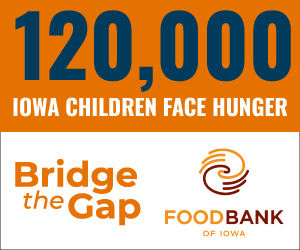Wells Fargo economists: U.S. 2024 outlook ‘generally’ remains resilient, too soon to say ‘storm has passed’
The big bank predicts the Fed is ‘probably’ done raising interest rates but will be slow to ease restrictive policy in 2024 to meet its 2% inflation goal

Consumer spending has kept the U.S. economy resilient in 2023, but Wells Fargo’s annual economic outlook report released this month predicts the country’s gross domestic product (GDP) will “contract modestly” in mid-2024 as inflation continues to slowly fall.
Economists at the fourth largest bank in the U.S., and Des Moines’ second-largest employer, caution in the report, “we believe it would be premature to claim that the economic storm has passed.”
“In our view, the U.S. economic outlook over the next year or so is far from sunny,” the report says. “A full-blown economic storm may not develop, but storm clouds likely will dominate the horizon for the foreseeable future.”
The report, issued Nov. 9, was produced by economist Jay H. Bryson; Nick Bennenbroek; Jackie Benson; and Shannon Seery Grein.
As the economy entered the fourth quarter of 2023, the Federal Open Market Committee (FOMC) at the Federal Reserve said the year-over-year change in the core personal consumption expenditures (PCE) deflator, which Fed officials believe is the best measure of the underlying rate of consumer price inflation, was 3.7% in September, according to the report.
That’s down from the 5.5% rate that was registered in September 2022. Consumer prices rose at 2.5% between June and September, with the Wells Fargo forecast predicting further moderation in the coming months.
But the report says the “battle against inflation has not yet been decisively won.”
Wells Fargo’s outlook predicts that “to be confident that inflation is returning to 2% on a” sustained basis, The FOMC likely will maintain a restrictive policy stance through the early months of 2024.
“In our view, the FOMC probably is done hiking interest rates, but it likely will be some time before the committee begins to ease policy,” the report says. “Therefore, the real fed funds rate will creep higher in the coming months as the FOMC maintains its target range for the federal funds rate at its current level of 5.25%-5.50%, while inflation continues to slowly fall toward 2%.”
“There already are some cracks that are beginning to appear in the economy, and these strains likely will intensify in the coming months as monetary restraint remains in place. … We acknowledge that the FOMC likely will not ease as much as we forecast if the economy manages to avoid a contraction,” the report says.
Wells Fargo predicts that even if the Fed meets its goal of a “soft landing” for the U.S. economy, real GDP growth in 2024 “likely will be subpar, at best, due to the elevated level of real interest rates that will be needed to wring inflation out of the economy.”
In the commercial real estate market, the report predicts struggles for the office and multifamily sectors, while fundamentals in the retail and industrial sectors are stronger.
According to the report, the rise in mortgage rates has weighed on the single-family housing market as the number of housing looks likely to be down roughly 10% in 2023 compared to last year.
In the multifamily market, Wells Fargo says persistent construction in recent years has outstripped demand, “cooling rents and lifting multifamily vacancy rates 2.3 percentage points from their cycle low in 2021.”
“While pricing is still clouded by the low level of transactions occurring, lower valuations and a potentially higher interest rate regime could present a challenging backdrop in the years ahead,” the report says.
The industrial real estate and warehouse markets have been bolstered by government investment in electric vehicle and transistor manufacturing through the Inflation Reduction Act, according to the report. That could benefit the Midwestern states of Michigan, Indiana and Ohio that have been targeted for electric vehicle battery production.
Population drops in the larger U.S. metropolitan areas, the Midwest and Northeast due to the pandemic, could have an impact on regional economies, if the national economy contracts in 2024, according to the report.
The Mountain West and Sun Belt states, which have seen population migration, could be better positioned, the report says.
For Iowa, data from the U.S. Department of Labor and Wells Fargo Economics cited in the report shows that as of September, the state has regained 98% of March/April 2020 job losses from the start of the COVID-19 pandemic.
That’s below the jobs recovery rate of surrounding Midwestern states, according to a chart in the report.
Internationally, the Wells Fargo economists predict the Eurozone countries as a group will avoid recession, but “sluggish” economic growth from 2023 will persist into 2024. China is also likely to continue its trend of slower than historic growth of its economy.
India’s economy could be a bright spot globally in 2024, according to the report, outperforming most other developing countries.
But the Wells Fargo economists said the Indian economy is not large enough to have a measurable effect on global GDP in 2024, which the report forecasts will grow by 2.4% next year.
Read Wells Fargo’s full 2024 Annual Outlook “Weathering the Storm” report here.

Mike Mendenhall
Mike Mendenhall is associate editor at Business Record. He covers economic development, government policy and law.










